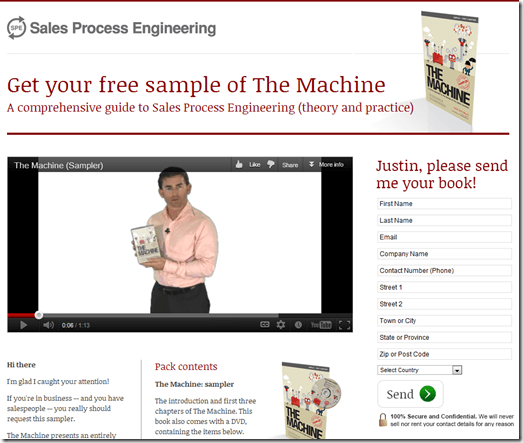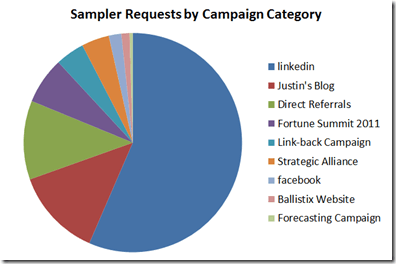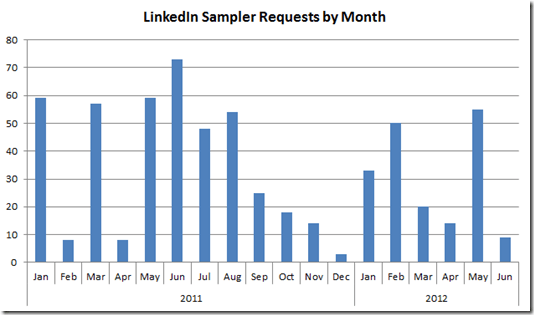A little over a year ago, I posted on our initial experiments with “social media” (or, more specifically, with pay-per-click advertising).
That post was well received so this one is an update. Actually, it’s more than an update: it’s a review of our entire US lead-generation machine. I hope it provides you an idea or two – or, perhaps, the courage to run some of your own promotional experiments with new media.
So, back in February 2011, I talked about how we launched our US operations at the depth of the recession and struggled to generate sales opportunities the way we do in Australia. The problem was that, in Australia, we had a house list containing many tens of thousands of executives – and in the US, we didn’t (and still don’t)!
I talked about how, when we launched here, we squandered a small fortune on PR, tradeshows, traditional advertising and traditional direct mail campaigns. And I related some encouraging results we were getting using pay-per-click (PPC) advertising (predominantly on LinkedIn) to give away reports and, in so doing, generate sales opportunities.
Since then we’ve done quite a bit of additional experimentation and automation. Here are the results. (If any of this doesn’t make sense, it’ll pay to read – or re-read – Chapter 9 of The Machine, which I posted last week.)
Offers
We tested a number of offers early in 2011 and the clear winner (by a ridiculous margin) was a sampler of The Machine (the first three chapters).
Of course, I love the fact that this offer is our best-performing because it means that we’re building the audience for the upcoming book at the same time we’re generating sales opportunities.
Because this is our best performing offer, pretty much all of our campaigns over this period point to versions of the one landing page, offering copies of The Machine (the sampler), along with a DVD containing a copy of my first book, a 2.5hr luncheon presentation and other good stuff.
It makes sense to have all campaigns point to the one ultimate offer as we have done because it simplifies opportunity management and enables you to automate your lead management to a greater degree.
On that note:
- We use AWeber to automate our lead-management process (form generation, auto-responders and list management)
- We have automated the import of sales opportunities into our CRM
- We pay a person I found here in LA (on Craigslist) to do all of our mail handling (she mail merges letters direct from our CRM and uses stamps.com to generate postage labels)
Audience (media)
The following chart shows most of the sales opportunities we have generated since January 2011, broken-down by campaign category.
You can see that PPC advertising on LinkedIn turned out to be a winner. It’s not our least expensive form of promotion (in terms of cost-per-opportunity) but it’s certainly the most scalable.
You can also see that we’re getting great value from this blog (with SEO referrals increasing steadily over the period) and from referrals. The Fortune Summit entry exists because Verne Harnish was kind enough to invite me to the stage to speak about our approach to sales commissions after Dan Pink’s presentation last year.
Creative execution
One of the great things about PPC advertising is that the creative component (words and pictures) is easy. Most media (e.g. Google, LinkedIn and Facebook) provide you with a limited amount of space and strict controls on how you can use it.
Here’s a sample of one of our many LinkedIn ads. (We have many because we’re regularly trialing new versions and because the response to individual versions fades quite quickly.)
The other creative component of these campaigns is the landing (or squeeze) page. You can see a sample of one of them above.
Here, creative execution can make a big difference. For example, we recently more than doubled our on-page conversion by adding a video of yours truly, imploring visitors to request the book.
The results
Let me tell you the results of just our LinkedIn activities. It makes sense to focus on LinkedIn because it’s the source of more than 50% of our opportunities and also because it’s the one media that we can readily scale.
Here’s a chart of our sampler requests over the period.
It’s important to note that much of the variability in these numbers comes from us running experiments and – in many cases – deliberately throttling-back our LinkedIn expenditure, either because Charlene (my sales coordinator) is overwhelmed or, more recently, because we have run out of delivery capacity here in the US (we’ll be adding more shortly).
Okay then, enough with the pretty pictures; let me show you how all this activity translates into money!
The economics
Over the period we’ve spent $29,071 with LinkedIn. From 24.3m impressions (showings of our ads), we’ve generated 5,687 clicks, at a cost of $5.11 each.
An average of 11% of these clicks have converted into sampler requests (this rate has risen markedly in recent times), meaning that we gave away 607 samplers (and generated the same number of sales opportunities).
It has cost us a little under $8 to fulfill each book request, meaning our total LinkedIn-related promotional expenditure is $33,927.
Now, this may sound like a lot but we need to compare it with the income we expect these opportunities will yield over time. Understandably, I wouldn’t give you this number even if I knew it, but I am prepared to admit that the lifetime value of a new client is significant enough to easily justify all this expenditure (and more).
The interesting thing in our case (and many of our clients have followed our lead here) is that we sell a Solution Design Workshop as part of our engagement process (i.e. before we ask for the ultimate order).
This means that our opportunity-management process generates income as well as incurring costs. This also means that it’s possible – at least in theory – to build a self-liquidating opportunity-management process and drive the overall cost-of-sale down to zero.
In our case, over the period in question, we can attribute at least six Solution Design Workshops to our LinkedIn campaign. These have generated an average (net) income of $6,160. If divide our total LinkedIn-related promotional expenditure by six you can see that it has cost us $5,654 to sell each of these workshops.
In other words the promotional cost of each is negative $500!
There’s no question in my mind that this analysis grossly undervalues our LinkedIn campaign. It ignores the Solution Design Workshops we have yet to sell to the 607 new people we’ve added to our house list. It ignores all the income we will earn over the years by introducing a percentage of these people to our Outsourced Sales Operations engagements. And it ignores the audience we are building for my upcoming book – and all the knock-on benefits that will ultimately flow from that.
But I have little interest in trying to quantify any of that right now. After all, a couple of years ago we were bleeding red ink in the US and struggling to generate any sales opportunities. Now, our constraint has shifted to where it belongs (our consultants), meaning that we can knuckle-down and focus on replicating the simple model we have operating right now.
I must admit that, moving to the US and starting here without a captive audience (outside of the TOC community) has forced me to learn lessons that I could have learned back in Australia, but probably wouldn’t have. If you’re not running these kinds of promotional experiments now I encourage you to do so – while you don’t need to!



